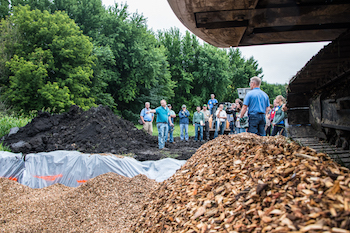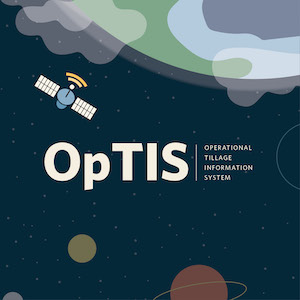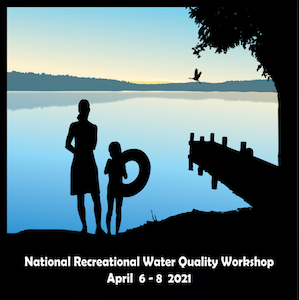Conservation in Action News February 2021
February 2021
Welcome
Hello everyone,
The takeaway from 2020 for me has been that we are stronger together than apart. Agriculture, by its n ecessity, impacts everyone, every day. That means we need everyone around the table to set a course to a future where everyone benefits from conservation. CTIC has been and will continue to be a community where all are welcome, but 2020 demonstrated that it takes work to ensure that everyone is invited.
ecessity, impacts everyone, every day. That means we need everyone around the table to set a course to a future where everyone benefits from conservation. CTIC has been and will continue to be a community where all are welcome, but 2020 demonstrated that it takes work to ensure that everyone is invited.
 ecessity, impacts everyone, every day. That means we need everyone around the table to set a course to a future where everyone benefits from conservation. CTIC has been and will continue to be a community where all are welcome, but 2020 demonstrated that it takes work to ensure that everyone is invited.
ecessity, impacts everyone, every day. That means we need everyone around the table to set a course to a future where everyone benefits from conservation. CTIC has been and will continue to be a community where all are welcome, but 2020 demonstrated that it takes work to ensure that everyone is invited.I’m proud of how our team has persevered through 2020. They have engaged with new technologies, trained in critical areas, and maintained and developed new relationships through it all. Currently, we are working with many of our members to lay the foundation for new partnerships that will lead us through 2021 and into our 40th anniversary year in 2022.
Meanwhile, we and our partners are making inroads to develop a market-based mechanism to compensate farmers for reducing phosphorus levels in the waterways of the Western Lake Erie Basin.
With other partners, we are getting ready to release an expanded data set from our Operational Tillage Information System (OpTIS). In addition to expanding the geography and adding another year of data, we are fine-tuning it to make OpTIS data a mainstay of evaluating changes in tillage and cover crop practices across a growing expanse of the Corn Belt.
We are constantly finding new ways to share information on cover crops, soil health, conservation practices from deep in the field to the edges of fields, as well as how conservation systems affect nitrogen and carbon cycles. Whether it's through webinars, online outlets or appropriately distanced live events, we will use all the tools at our disposal to keep people informed and engaged.
And we are always exploring the big questions around conservation farming practices in a changing climate, making sure we can help farmers, policy makers and everyone in between navigate a course that is both economically and environmentally sustainable into the future.
As always, we appreciate our members and partners. We are glad you are with us on this journey. If you have not yet joined or renewed your membership, please do so today. And if you have kept your membership current, fasten your seatbelt: 2021 is already shaping up to be a busy and exciting year!
Enjoy the day,
Mike
Mike Komp, Executive Director
Join CTIC or Renew Your Membership Today!
For four decades, CTIC has brought a remarkable range of people to the table to talk about conservation agriculture. Nowhere else is there such a great opportunity to meet policy makers, agribusiness leaders, farmers, researchers, conservation specialists, crop consultants and others...all drawn together by a mutual interest in conservation technologies that are better for farmers and better for the environment.

CTIC is a membership organization, which means your membership—your participation and your dues—keep the doors open. You also give us our momentum, driving us forward on our mission to Connect, Inform and Champion. Your membership helps us put projects on the ground, bring innovations to life and spread the word about conservation systems that work.
Our members are our biggest advocates, our advisors and our inspiration.
If you're a member of CTIC, thank you for your support. If you want to become a member, visit our website or contact komp@ctic.org to explore membership levels and benefits.
DNDC Webinar on CTIC's Website
A recorded one-hour webinar on using CTIC data to analyze trends in conservation farming practices across the Corn Belt is available on CTIC's website. The video, recorded as a live webinar last October, includes a discussion of the use of Operational Tillage Information System (OpTIS) data through the De-Nitrification/De-Composition (DNDC) model, as well as presentations by three users of the data:
- Ward Smith, Senior Physical Scientist, Agriculture and Agri-Food Canada
- Steven Rosenzweig, Senior Soil Scientist, General Mills
- Debbie Reed, Executive Director, Ecosystem Services Market Consortium
Bill Salas of Regrow (fo rmerly Dagan, Inc.), a primary developer of DNDC, is also featured in the webinar, describing the model and its uses.
rmerly Dagan, Inc.), a primary developer of DNDC, is also featured in the webinar, describing the model and its uses.
 rmerly Dagan, Inc.), a primary developer of DNDC, is also featured in the webinar, describing the model and its uses.
rmerly Dagan, Inc.), a primary developer of DNDC, is also featured in the webinar, describing the model and its uses.DNDC is a process-based model that predicts emissions of carbon dioxide, methane, ammonia, and nitrous oxide from soil systems under various management regimes. The model also estimates changes in soil organic carbon resulting from management changes. Combined with 14 years of satellite data (2005-2018) from OpTIS, DNDC provides deep insight into the environmental effects of conservation tillage and cover crops.
CTIC's website features easy-to-use visualization tools for both OpTIS and DNDC data. The tools can be used by a wide range of interested people, including:
- Scientists
- Policy makers
- Administrators of carbon markets
- Agribusiness
- Conservationists
- Farm advisors
"With 14 years' worth of data reported at the watershed HUC-8 or crop reporting district scale, OpTIS provides insight into snapshots or trends of soil health practices across the Corn Belt," notes Dave Gustafson, OpTIS project director for CTIC. "Running these data through DNDC adds a very exciting tool for understanding the effects of those practices on key metrics such as soil carbon, and using the visualization tools on our website really brings it all to life."
View the DNDC webinar here on CTIC's website.
National Recreational Water Quality Workshop, April 6-8
Working closely with US EPA, CTIC is taking the agency's three-day National Recreational Water Quality Workshop virtual this year. Click here for the agenda.

The workshop provides a nationwide forum for recreational water quality managers, stakeholders, researchers and public health officials at all levels to share information and ideas about implementing successful recreational water quality programs. The program will focus on fecal contamination and harmful algal blooms (HABs).
Pre-recorded presentations will be available for viewing beginning March 15, 2021 on the CTIC website, and viewers can submit questions through a comment box after each presentation. Live panel discussions April 6 through 8 will address questions and key issues raised by the presentations, and allow participants to chat with poster authors during live poster presentations.
Registration is free but required to access the workshop. Click here to register.
2021 Conservation in Action Tour Planning Continues
With expectations of continued travel restrictions late into 2021, CTIC is currently planning the Conservation in Action tour, which is likely to include recorded, live remote and in-person elements. We are working closely with the Alliance of Crop, Soil and Environmental Science Societies (ACSESS) to continue linking the tour with the Sustainable Agriculture Conference as we did last year. Meanwhile, we are finding ways to include expanded content and insight from farmers, conservation specialists, policy makers and more.
For the past 14 years, the CTIC Conservation in Action Tour has been a highlight of the summer calendar, a way to share deep insights into conservation practices on the ground with a wide range of participants.
Last year's virtual tour provided a new way for participants to connect with a dynamic farming family and dig into the question of how they've made conservation stick across the generations.
The 2021 tour may end up looking different from past tours (what isn't different lately?), but the insights will continue to flow. Watch CTIC's website for updates!

